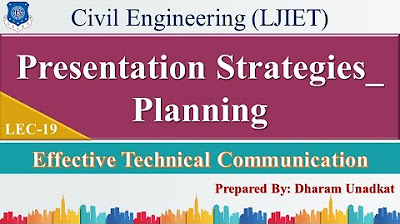Audience Analysis for a MIXED Audience // Knowing Your Audience in Public Speaking
Summary
TLDRIn this video script, Anita from Word Cortex discusses strategies for effectively presenting to a mixed audience. She emphasizes the importance of defining the presentation's purpose and success metrics before analyzing the audience. Anita identifies three audience groups: decision-makers, influencers, and seat warmers, advising presenters to focus on the first two groups. She provides a free worksheet to assist with detailed audience analysis, ensuring the presentation aligns with the presenter's goals rather than trying to please everyone.
Takeaways
- 🎯 **Define Your Purpose**: Clearly establish what success looks like for your presentation before analyzing your audience.
- 🧐 **Know Your Audience**: Understand that you can't please everyone and focus on decision-makers and influencers.
- 👥 **Identify Key Groups**: Recognize three types of audience members: decision-makers, influencers, and seat warmers.
- 📈 **Success Metrics**: Your presentation's success might be getting a job, a promotion, leads, awareness, or an academic degree.
- 🚫 **Avoid Tailoring to the Majority**: Tailoring your presentation to the majority can backfire, especially in a mixed audience.
- 📋 **Use a Worksheet**: Utilize a worksheet with step-by-step prompts to perform detailed audience analysis.
- 🤔 **Anticipate Resistance**: Prepare for potential resistance and understand why your audience might lose attention.
- 📊 **Analyze Demographics and Psychographics**: Consider the audience's age, interests, knowledge levels, and environment.
- 🌐 **Public Speaking Scenarios**: Apply these strategies in conferences, public seminars, or company-wide meetings.
- 🔗 **Resource Availability**: Access a free worksheet and video for in-depth guidance on audience analysis.
Q & A
What is the safest approach when preparing a presentation for a mixed audience?
-The safest approach is not necessarily to tailor your presentation to the majority, as this can sometimes backfire. Instead, it involves strategically approaching communication by defining the purpose of your presentation and setting your success metric.
Who is Anita and what is her role in the transcript?
-Anita is from Word Cortex, and she is the speaker in the transcript providing guidance on how to communicate effectively with a mixed audience.
What does conventional audience analysis involve?
-Conventional audience analysis involves preparing and tailoring your presentation based on the demographics, psychographics, knowledge levels, topic familiarity, and situation or environment of the people in your audience.
What are some examples of speaking to a mixed audience?
-Examples include speaking at a conference where anyone with a ticket can attend, a public seminar, or a company-wide or multi-departmental meeting.
What are the two key steps to knowing your audience for a mixed audience?
-The two key steps are: 1) Clearly defining the purpose of your presentation and setting your success metric, and 2) Knowing that you cannot please everyone in the room.
What does success look like in the context of a presentation?
-Success could mean getting a job, a promotion, capturing leads for your business, spreading awareness on a topic, or achieving a degree, depending on what the presenter defines as their success metric.
What are the three different groups of people Anita identifies in a mixed audience?
-The three groups are decision-makers, influencers, and seat warmers. Decision-makers have purchasing power or directly affect the success metric, influencers have some influence over the success metric, and seat warmers are there for the free amenities or out of curiosity but have no way to drive the success metric.
Why is it important to focus on decision-makers and influencers when presenting to a mixed audience?
-Focusing on decision-makers and influencers is important because they have the power or influence to affect the presenter's success metric, unlike seat warmers who are less likely to contribute to the presenter's goals.
What is a seat warmer in the context of a mixed audience?
-A seat warmer is an individual who attends an event for free amenities like coffee or lunch, or out of curiosity, but they have no direct influence or decision-making power related to the presenter's success metric.
What is the purpose of the free worksheet mentioned in the transcript?
-The free worksheet is designed to help users perform a detailed audience analysis by providing step-by-step question prompts to understand the audience better, determine content inclusion and exclusion, anticipate resistance, and understand potential attention loss.
How can one access the free worksheet mentioned by Anita?
-The free worksheet can be accessed by grabbing the link provided in the description below the video.
Outlines

Cette section est réservée aux utilisateurs payants. Améliorez votre compte pour accéder à cette section.
Améliorer maintenantMindmap

Cette section est réservée aux utilisateurs payants. Améliorez votre compte pour accéder à cette section.
Améliorer maintenantKeywords

Cette section est réservée aux utilisateurs payants. Améliorez votre compte pour accéder à cette section.
Améliorer maintenantHighlights

Cette section est réservée aux utilisateurs payants. Améliorez votre compte pour accéder à cette section.
Améliorer maintenantTranscripts

Cette section est réservée aux utilisateurs payants. Améliorez votre compte pour accéder à cette section.
Améliorer maintenant5.0 / 5 (0 votes)






